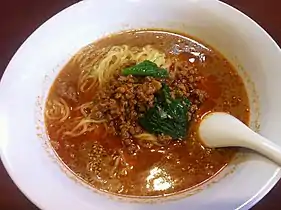Bashu culture
Bashu culture (Chinese: 巴蜀文化; pinyin: Bāshǔ Wénhuà), sometimes also named Chongqing-Sichuan culture, refers to the culture of Sichuan province and Chongqing city, China and the surrounding areas, including parts of the neighboring provinces of Yunnan and Guizhou, since the Han Chinese groups in these two provinces also primarily speak Southwestern Mandarin nowadays. It has a long history of over 3000 years, widely regarded as one of the cradles of modern Chinese civilization.[1][2][3]

Pattern of the Golden Sun Bird discovered in Jinsha site
Traditional language
Architecture

Du Fu Thatched Cottage showcases Sichuanese architecture.

Linpan in Chengdu Plain is a well-known landmark in Chengdu Plain, Sichuan.

Farmhouse in Chengdu Plain
Sichuanese garden
Performing arts
Food culture
 Kung Pao chicken, one of the best known dishes of Sichuan cuisine
Kung Pao chicken, one of the best known dishes of Sichuan cuisine
 Hot pot in Mala style
Hot pot in Mala style
 Mixed sauce noodles (杂酱面)
Mixed sauce noodles (杂酱面) Sichuanese cuisine is renowned for its spicy dishes. Pictured is Dandan noodles.
Sichuanese cuisine is renowned for its spicy dishes. Pictured is Dandan noodles.
Others
- Religious sites in Sichuan
 View of the Temple of the Yellow Dragon (Chinese Buddhism) in Huanglong.
View of the Temple of the Yellow Dragon (Chinese Buddhism) in Huanglong. Statues of buddhas at Litang Monastery of the Tibetan tradition.
Statues of buddhas at Litang Monastery of the Tibetan tradition. A pavilion of the Shangqing Temple (Taoist) in Qingchengshan, Chengdu.
A pavilion of the Shangqing Temple (Taoist) in Qingchengshan, Chengdu. Golden Temple of Mount Emei (Chinese Buddhism).
Golden Temple of Mount Emei (Chinese Buddhism).
References
- 巴蜀文化渊源. huaxia.com. June 2006.
- 巴蜀文化. hk.chiculture.net.
- 四川师范大学巴蜀文化中心. Center for Bashu Cultural Studies, Sichuan Normal University.
This article is issued from Wikipedia. The text is licensed under Creative Commons - Attribution - Sharealike. Additional terms may apply for the media files.
